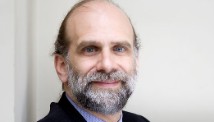The Conclave of Cardinals that will elect a new pope will meet in the Sistine Chapel in Vatican City.
STORY HIGHLIGHTS
- Bruce Schneier: Rules for picking a new pope are very detailed
- He says elaborate precautions are taken to prevent election fraud
- Every step of the election process is observed by people who know each other
- Schneier: Vatican's procedures, centuries in the making, are very secure
Editor's note: Bruce Schneier is a security technologist and author of "Liars and Outliers: Enabling the Trust Society Needs to Survive." In 2005, before the conclave that elected Pope Benedict XVI, Schneier wrote a piece on his blog about the process. This essay is an updated version, reflecting new information and analysis.
(CNN) -- As the College of Cardinals prepares to elect a new pope, security people like me wonder about the process. How does it work, and just how hard would it be to hack the vote?
The rules for papal elections are steeped in tradition. John Paul II last codified them in 1996, and Benedict XVI left the rules largely untouched. The "Universi Dominici Gregis on the Vacancy of the Apostolic See and the Election of the Roman Pontiff" is surprisingly detailed.
Every cardinal younger than 80 is eligible to vote. We expect 117 to be voting. The election takes place in the Sistine Chapel, directed by the church chamberlain. The ballot is entirely paper-based, and all ballot counting is done by hand. Votes are secret, but everything else is open.

Bruce Schneier
First, there's the "pre-scrutiny" phase.
"At least two or three" paper ballots are given to each cardinal, presumably so that a cardinal has extras in case he makes a mistake. Then nine election officials are randomly selected from the cardinals: three "scrutineers," who count the votes; three "revisers," who verify the results of the scrutineers; and three "infirmarii," who collect the votes from those too sick to be in the chapel. Different sets of officials are chosen randomly for each ballot.
Each cardinal, including the nine officials, writes his selection for pope on a rectangular ballot paper "as far as possible in handwriting that cannot be identified as his." He then folds the paper lengthwise and holds it aloft for everyone to see.
When everyone has written his vote, the "scrutiny" phase of the election begins. The cardinals proceed to the altar one by one. On the altar is a large chalice with a paten -- the shallow metal plate used to hold communion wafers during Mass -- resting on top of it. Each cardinal places his folded ballot on the paten. Then he picks up the paten and slides his ballot into the chalice.
Pope may change rules to allow earlier election
If a cardinal cannot walk to the altar, one of the scrutineers -- in full view of everyone -- does this for him.
If any cardinals are too sick to be in the chapel, the scrutineers give the infirmarii a locked empty box with a slot, and the three infirmarii together collect those votes. If a cardinal is too sick to write, he asks one of the infirmarii to do it for him. The box is opened, and the ballots are placed onto the paten and into the chalice, one at a time.
When all the ballots are in the chalice, the first scrutineer shakes it several times to mix them. Then the third scrutineer transfers the ballots, one by one, from one chalice to another, counting them in the process. If the total number of ballots is not correct, the ballots are burned and everyone votes again.
To count the votes, each ballot is opened, and the vote is read by each scrutineer in turn, the third one aloud. Each scrutineer writes the vote on a tally sheet. This is all done in full view of the cardinals.
The total number of votes cast for each person is written on a separate sheet of paper. Ballots with more than one name (overvotes) are void, and I assume the same is true for ballots with no name written on them (undervotes). Illegible or ambiguous ballots are much more likely, and I presume they are discarded as well.
Then there's the "post-scrutiny" phase. The scrutineers tally the votes and determine whether there's a winner. We're not done yet, though.
The revisers verify the entire process: ballots, tallies, everything. And then the ballots are burned. That's where the smoke comes from: white if a pope has been elected, black if not -- the black smoke is created by adding water or a special chemical to the ballots.
Being elected pope requires a two-thirds plus one vote majority. This is where Pope Benedict made a change. Traditionally a two-thirds majority had been required for election. Pope John Paul II changed the rules so that after roughly 12 days of fruitless votes, a simple majority was enough to elect a pope. Benedict reversed this rule.
How hard would this be to hack?
First, the system is entirely manual, making it immune to the sorts of technological attacks that make modern voting systems so risky.
Second, the small group of voters -- all of whom know each other -- makes it impossible for an outsider to affect the voting in any way. The chapel is cleared and locked before voting. No one is going to dress up as a cardinal and sneak into the Sistine Chapel. In short, the voter verification process is about as good as you're ever going to find.
A cardinal can't stuff ballots when he votes. The complicated paten-and-chalice ritual ensures that each cardinal votes once -- his ballot is visible -- and also keeps his hand out of the chalice holding the other votes. Not that they haven't thought about this: The cardinals are in "choir dress" during the voting, which has translucent lace sleeves under a short red cape, making sleight-of-hand tricks much harder. Additionally, the total would be wrong.
The rules anticipate this in another way: "If during the opening of the ballots the scrutineers should discover two ballots folded in such a way that they appear to have been completed by one elector, if these ballots bear the same name, they are counted as one vote; if however they bear two different names, neither vote will be valid; however, in neither of the two cases is the voting session annulled." This surprises me, as if it seems more likely to happen by accident and result in two cardinals' votes not being counted.
Ballots from previous votes are burned, which makes it harder to use one to stuff the ballot box. But there's one wrinkle: "If however a second vote is to take place immediately, the ballots from the first vote will be burned only at the end, together with those from the second vote." I assume that's done so there's only one plume of smoke for the two elections, but it would be more secure to burn each set of ballots before the next round of voting.
The scrutineers are in the best position to modify votes, but it's difficult. The counting is conducted in public, and there are multiple people checking every step. It'd be possible for the first scrutineer, if he were good at sleight of hand, to swap one ballot paper for another before recording it. Or for the third scrutineer to swap ballots during the counting process. Making the ballots large would make these attacks harder. So would controlling the blank ballots better, and only distributing one to each cardinal per vote. Presumably cardinals change their mind more often during the voting process, so distributing extra blank ballots makes sense.
There's so much checking and rechecking that it's just not possible for a scrutineer to misrecord the votes. And since they're chosen randomly for each ballot, the probability of a cabal being selected is extremely low. More interesting would be to try to attack the system of selecting scrutineers, which isn't well-defined in the document. Influencing the selection of scrutineers and revisers seems a necessary first step toward influencing the election.
If there's a weak step, it's the counting of the ballots.
There's no real reason to do a precount, and it gives the scrutineer doing the transfer a chance to swap legitimate ballots with others he previously stuffed up his sleeve. Shaking the chalice to randomize the ballots is smart, but putting the ballots in a wire cage and spinning it around would be more secure -- albeit less reverent.
I would also add some kind of white-glove treatment to prevent a scrutineer from hiding a pencil lead or pen tip under his fingernails. Although the requirement to write out the candidate's name in full provides some resistance against this sort of attack.
Probably the biggest risk is complacency. What might seem beautiful in its tradition and ritual during the first ballot could easily become cumbersome and annoying after the twentieth ballot, and there will be a temptation to cut corners to save time. If the Cardinals do that, the election process becomes more vulnerable.
A 1996 change in the process lets the cardinals go back and forth from the chapel to their dorm rooms, instead of being locked in the chapel the whole time, as was done previously. This makes the process slightly less secure but a lot more comfortable.
Of course, one of the infirmarii could do what he wanted when transcribing the vote of an infirm cardinal. There's no way to prevent that. If the infirm cardinal were concerned about that but not privacy, he could ask all three infirmarii to witness the ballot.
There are also enormous social -- religious, actually -- disincentives to hacking the vote. The election takes place in a chapel and at an altar. The cardinals swear an oath as they are casting their ballot -- further discouragement. The chalice and paten are the implements used to celebrate the Eucharist, the holiest act of the Catholic Church. And the scrutineers are explicitly exhorted not to form any sort of cabal or make any plans to sway the election, under pain of excommunication.
The other major security risk in the process is eavesdropping from the outside world. The election is supposed to be a completely closed process, with nothing communicated to the world except a winner. In today's high-tech world, this is very difficult. The rules explicitly state that the chapel is to be checked for recording and transmission devices "with the help of trustworthy individuals of proven technical ability." That was a lot easier in 2005 than it will be in 2013.
What are the lessons here?
First, open systems conducted within a known group make voting fraud much harder. Every step of the election process is observed by everyone, and everyone knows everyone, which makes it harder for someone to get away with anything.
Second, small and simple elections are easier to secure. This kind of process works to elect a pope or a club president, but quickly becomes unwieldy for a large-scale election. The only way manual systems could work for a larger group would be through a pyramid-like mechanism, with small groups reporting their manually obtained results up the chain to more central tabulating authorities.
And third: When an election process is left to develop over the course of a couple of thousand years, you end up with something surprisingly good.
Follow @CNNOpinion on Twitter.
Join us at Facebook/CNNOpinion.
The opinions expressed in this commentary are solely those of Bruce Schneier.












